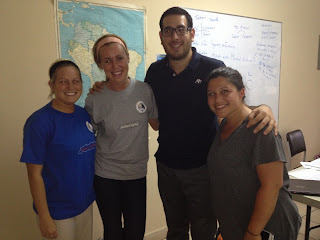After my experience abroad, I can best relate to the points
of Immersion and Engagement from Cambourne’s Conditions.
After I have been immersed into real life experiences and attention towards a
second language, I can better apply it to my future teaching toward my ELLs. During my time in Costa Rica, my curiosity,
puzzlement, and experienced dissonance caused me to “need to know” a resolution. A genuine curiosity for relating to,
empathizing, and effectively communicating with ELL students has been created.
Conditions 3-7 best relate to my teaching experiences at Calle Hernandez Primary and Santa Elena Primary. The condition Demonstration is probably the condition I found most significant and relevant in my time working with students by learning the second language teaching method of “demonstration, not translation”. Through small group lessons and independent work, my students experienced the conditions of Risk or Approximation and Use of Employment of Learning. It was perfectly acceptable for my students to make mistakes or not understand a concept during their lessons, just like it was okay for me to make mistakes (lots of mistakes) in the Spanish classes I took at CPI. Keeping the conditions of Expectations and Feedback in mind was equally as important when instructing my students. Although they were not proficient in English and often struggled to understand and comprehend the purpose of my lessons, I held high expectations for them and gave them feedback throughout their learning and work! My students recognized these expectations and were proud of themselves when the expectations were reached.
Conditions 3-7 best relate to my teaching experiences at Calle Hernandez Primary and Santa Elena Primary. The condition Demonstration is probably the condition I found most significant and relevant in my time working with students by learning the second language teaching method of “demonstration, not translation”. Through small group lessons and independent work, my students experienced the conditions of Risk or Approximation and Use of Employment of Learning. It was perfectly acceptable for my students to make mistakes or not understand a concept during their lessons, just like it was okay for me to make mistakes (lots of mistakes) in the Spanish classes I took at CPI. Keeping the conditions of Expectations and Feedback in mind was equally as important when instructing my students. Although they were not proficient in English and often struggled to understand and comprehend the purpose of my lessons, I held high expectations for them and gave them feedback throughout their learning and work! My students recognized these expectations and were proud of themselves when the expectations were reached.
First week of Spanish class with Roberto!
Consistent with high expectations of students, the condition
of Responsibility follows students
for their learning. This is Cambourne’s eighth
condition and explains if students aren’t gradually given responsibly for their
learning, the results of their studying will be short-term and
meaningless. When responsibility is
accomplished, complete Trust has
been established between the teacher and student. Cambourne’s final condition of trust encompasses
mutual respect, deep relationships, and a feeling of security that allows
students to take risks and try new things.
Based on this knowledge of Cambourne’s Conditions coupled with my time in Costa Rican schools, I now have a much deeper understanding of the academic and linguistic struggles of ELL students. It is estimated that 25% of elementary students in 2012-2013 are Hispanic and will undoubtedly come from a variety of educational, social, and personal backgrounds and experiences. As a future public school teacher, I must empathize with and reach my ELL students by creating a classroom that is conducive for meaningful learning and new experiences. I look forward to educating myself on the background and cultures of my ELL students and fostering a sense of community no matter what language is used within my classroom!





I am also learning Spanish as a second language. The Costa Rica Spanish Language School offers also housing options. Willing individuals can take up residence with local host family at the most beautiful locations where a Chac Mool campus can be located as well. Their programs benefit and have been made for all kinds of participants, teenagers, adults or small children.
ReplyDelete